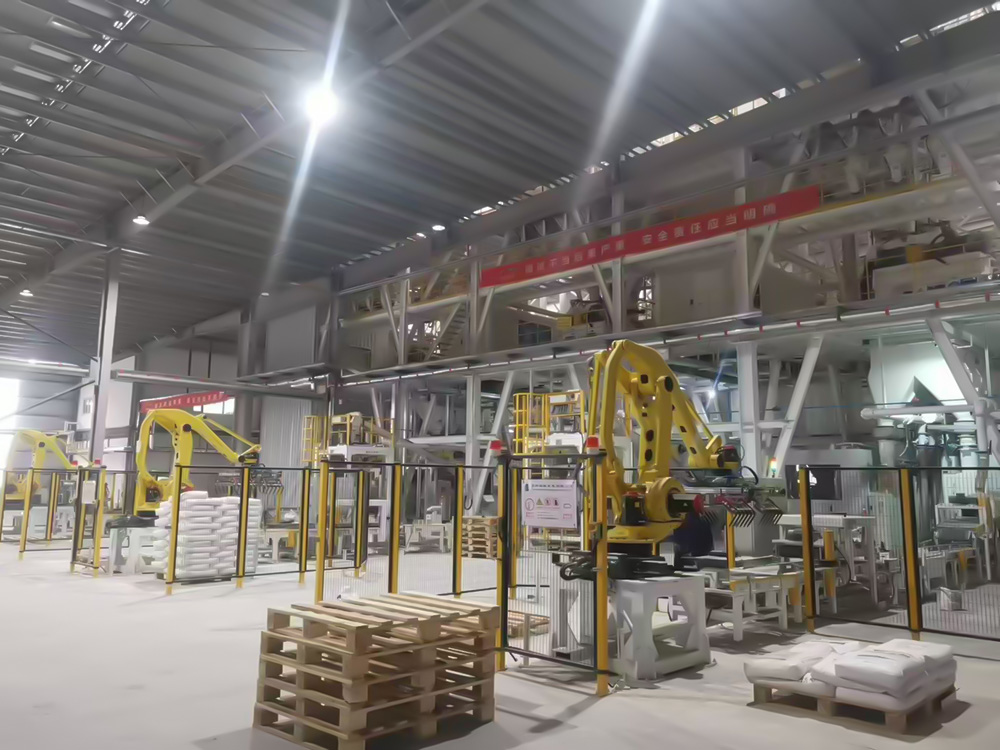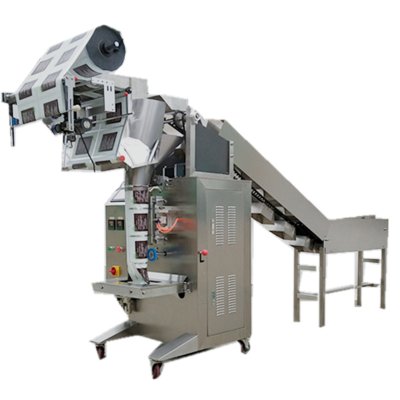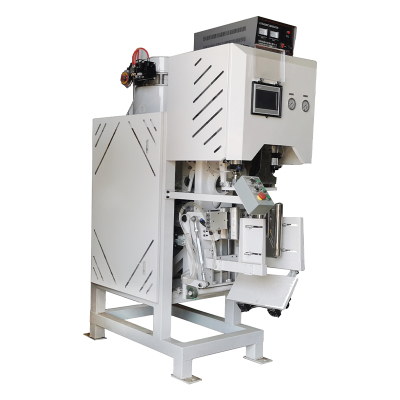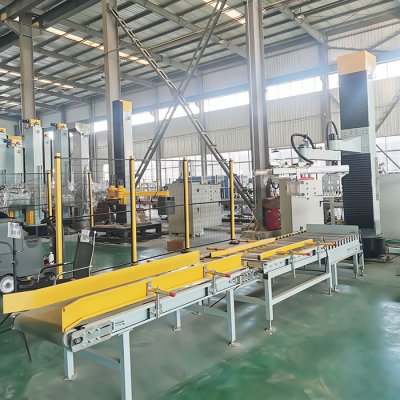Robot packaging and palletizing site
1. Packaging equipment (pre-process)
Automatic packaging machine
Applicable materials: powder (flame retardant, resin), granules (nylon, PBT), flakes (elastomer).
Type:
Valve bag packaging machine (dust-proof, for fine powder such as carbonizer).
Open bag packaging machine (granules or short fibers such as polyolefins).
Liquid filling machine (acrylic, polyurethane adhesives).
Weighing and sealing equipment
Checkweigher: ensure the weight accuracy of each bag (such as engineering plastic granules).
Heat sealer/sewing machine: seal packaging bags (dehydrating agents that need to be moisture-proof).
Container packaging equipment
Tonnage bag (FIBC) packaging machine: for large-volume bulk materials (such as synthetic rubber).
Barrel/canned line: liquid or viscous materials (fire retardant coatings, silicone).
2. Palletizing core equipment
Robot palletizing system
Features: high flexibility, can handle special-shaped materials (such as rubber blocks, foam).
Gripper Type:
Suction Cup (flat bags/boxes).
Gripper (irregular elastomers, silicone rubber blocks).
Applications: Synthetic rubber, TPE, and barrels of fire-retardant coatings.
Bremetz Robotic Palletizer
Features: Ultra-high speed (≥1000 times/hour), suitable for lightweight and small items (such as small packages of nylon pellets).
3. Auxiliary Equipment
Conveyor System
Belt/Chain Conveyor (connects packaging and palletizing).
Roller Conveyor (boxes of PBT or polyolefins).
Packet Arranger: Adjusts the position of bags and ensures stability.
Automatic Pallet Warehouse: Supply empty pallets (wooden/plastic/steel).
4. Post-Processing Equipment
Stretch Wrapper: Secures pallets with stretch film (moisture-proof resin, flame retardant).
Strapper: Reinforces with metal/PP strapping (heavy materials such as engineering plastics).
Labeler: Applies product information or barcodes.
Palletizing processes for the materials (flame retardants, adhesives, silicone rubber, polyurethane, etc.) vary depending on the material's properties (e.g., powder, granules, pellets, or liquid form). Below is a general guide to palletizing these materials, along with specific considerations for each:
1. General Palletizing Process
The typical steps for palletizing bulk materials include:
Material Handling – Conveying the product (belt, screw, or pneumatic conveyor).
Weighing & Metering – Ensuring consistent batch sizes.
Compression (if briquetting or compacting) – For powders or loose materials.
Palletizing – Stacking bags, boxes, or bulk containers onto pallets.
Stretch Wrapping/Securing – Stabilizing the load for transport.
For granules, pellets, or powders, automated palletizers (e.g., robotic, layer, or rotary palletizers) are common. For liquids or adhesives, intermediate steps like drum filling or tote packing may be required before palletizing.
2. Material-Specific Palletizing Considerations
A. Powders & Granules (Flame Retardants, Resins, Dehydrating Agents, Carbonizing Agents, Foaming Sources)
Challenge: Dust generation, moisture sensitivity.
Solution:
Use closed-system pneumatic conveyors to prevent contamination.
Vacuum loading for fine powders.
Automatic bagging + robotic palletizing for 25–50 lb bags.
Big Bag (FIBC) palletizing for bulk quantities.
B. Pellets (Nylon, PBT, Polyolefin, Engineering Plastics, PU Particles)
Challenge: Static buildup, pellet breakage.
Solution:
Vibratory feeders to prevent jamming.
Anti-static palletizers to reduce dust attraction.
Layer palletizing for uniform stacking.
C. Rubber & Elastomers (Synthetic Rubber, Silicone Rubber, Thermoplastic Elastomers)
Challenge: Sticky or irregularly shaped materials.
Solution:
Cooling before palletizing (if extruded).
Intermediate crating for soft rubber blocks.
Robotic grippers for handling non-standard shapes.
D. Liquids & Adhesives (Acrylic Acid, Polyurethane, Fire Retardant Coatings)
Challenge: Spills, curing during storage.
Solution:
Drum or tote filling first, then palletizing containers.
UV-resistant wrapping for light-sensitive chemicals.
Hazardous material compliance (if flammable).
E. Foams & Lightweight Materials (Polyurethane Foam, Foaming Agents)
Challenge: Low density, bulky shapes.
Solution:
Compression palletizing to reduce volume.
Vacuum lifting systems for lightweight blocks.
3. Automation & Equipment Selection
Robotic Palletizers: Best for mixed loads or irregular shapes (e.g., elastomers, PU particles).
Layer Palletizers: Ideal for uniform bags or boxes (e.g., nylon pellets, PBT).
High-Speed Palletizers: For large-scale production (e.g., polyolefin, engineering plastics).
Stretch Wrappers & Strapping: Essential for stabilizing loads.
4. Safety & Compliance
Fire Safety: Critical for flame retardants, PU, and organic silicon (spark-proof equipment).
Dust Control: Needed for carbonizing agents and powders (NEC/ATEX standards).
Chemical Resistance: Palletizers handling adhesives or acrylic acid should use stainless steel or coated components.
Conclusion
The palletizing method depends on the material's form (powder, pellet, liquid) and properties (flammability, stickiness, density). Automated robotic or layer palletizers are common for solid materials, while liquids require intermediate containerization. Always consider material-specific hazards (dust, static, flammability) when selecting equipment.






